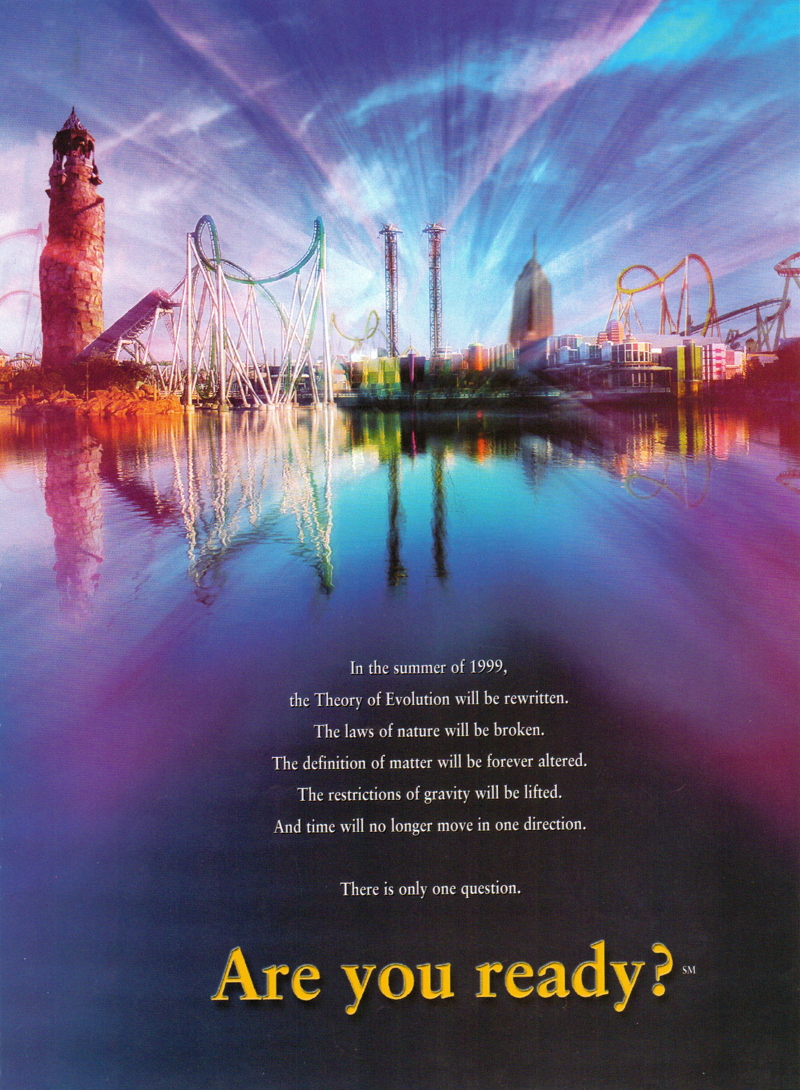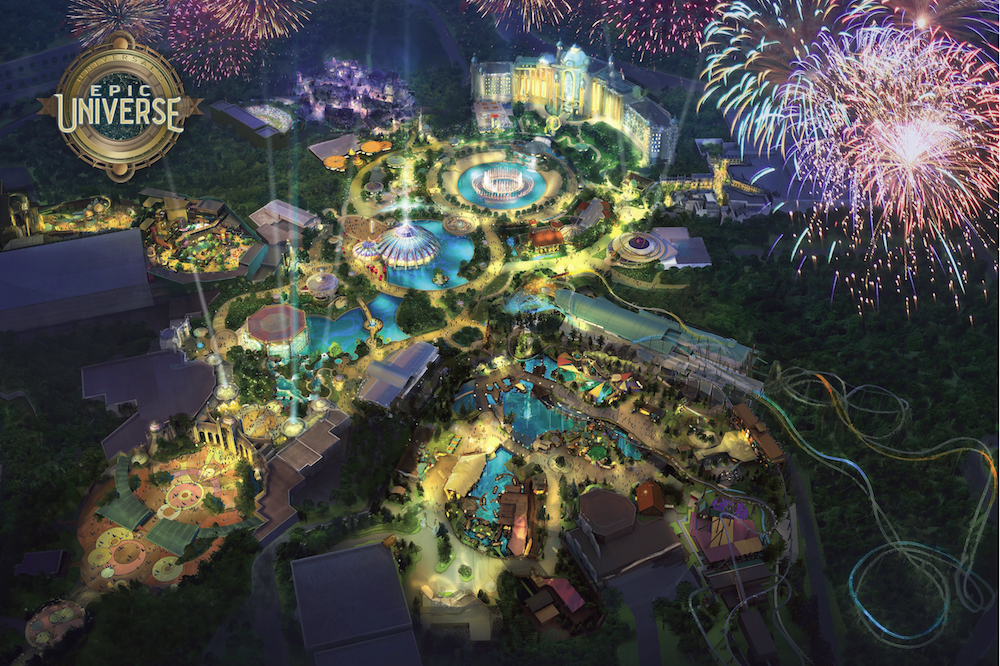A trademark sealed the resort’s fate on March 12th, 1998. There would be no Escape.
Universal bought a $60 million ad blitz, doubling what Disney spent in 1998, and worked out an additional $100 million from corporate partners like Coca-Cola and Dodge. It was the only way to sway a mouse-happy audience on “The Orlando Vacation Destination for the 21st Century.”
It was the only way to sell Universal Studios Escape.
The first commercials played on Universal home video releases, narrated by Don LaFontaine, the legendary voice behind “In a world...”
“Nobody brings the motion pictures to life like Universal Studios Florida,” he croons, over heartfelt montage of the park’s greatest hits and biggest smiles. “But the excitement has just begun.”
Islands of Adventure is still embryonic, shown off without a single frame of the actual park. Toon Lagoon and Lost Continent are absent entirely. “The next generation of theme park” is advertised, at least for a split-second, with footage of the Steel Phantom at Kennywood, one of only two amusement parks designated as a National Historic Landmark.
Before the ordinary viewer could notice, the logo fades in. The studio arches, the lighthouse, and the iconic globe all burnished in gold atop the title: Universal Studios Escape.
At no point in the commercial does it mention Portofino Bay, the first hotel to open, or CityWalk. Beyond the “next generation of theme park,” there’s no clue that it’s a separate experience at all.
But it does recommend viewers call their travel agent or visit the website USF.com.
In hindsight, that address was a bellwether. It was still the park’s original website when the campaign started. As the campaign exploded, so did the site.
Brochures demanded an answer - Are you ready? They also insisted on calling the new park “Universal Studios Islands of Adventure” and nothing less. But they did promise plenty to see: “Give Us Three Days and Nights, We’ll Give You a Whole New Universe.”

Confused? Just head over to UEscape.com for more information.
Disney’s Animal Kingdom opened on April 22nd, 1998, shortly after Universal’s first salvo, with a massive marketing push of its own that culminated in a two-hour ABC special.
Entertainment analysis Harold Vogel said sooth before either ribbon was cut: “The marketing battle will be so costly that they’ll depress profits at both parks - at least for a while. I suspect they may both be a little disappointed the first year out.”
Projections for Animal Kingdom calculated a 20% leech rate from the attendance of Disney’s other parks. The real number was closer to 40%. It met the 6 million guest mark, as predicted, but with an 8% decline in attendance at the Magic Kingdom and 10% decline at both Epcot and Disney-MGM Studios.
Universal’s numbers held firm - only way out was through now.
In 1999, with only months left, the commercials got bigger.
A teenager throws a frisbee at the dog park and two-ton triceratops bounds after it. Doc Ock fights Spider-Man on the wing of a 747 headed to, you guessed it, Sunny Florida. The Cat in the Hat sneaks green eggs and ham onto the menu of a roadside diner. All wrapped up with the same bow, the Universal Studios Escape logo, now with one noticeable revision - “Orlando,” right beneath “Escape.”
That at least placed the resort, but matching commercials for existing attractions like Terminator 2:3D muddied the water all over again - See the old and the new, both at Universal Studios Escape Orlando!
Even the coverage couldn’t quite parse the difference. A Wired spotlight on The Amazing Adventures of Spider-Man described Escape as “an expansion of Universal Studios Florida, its existing tourist trap.” Kelly Monaghan’s annual travel guide led with a one-page explanation titled “Just What Is Universal Studios Escape?”
Soft openings for Islands of Adventure began on March 27, then came judgment day on May 28.
The grand opening was a resounding success celebrated with towering inflatables and trademark explosions.
Seven months later, Universal had to issue a statement to the Orlando Sentinel denying rumors that the Escape brand would be abandoned and assuring it would “just take time to get the message across.”
In its first half-year of existence, Islands of Adventure drew 3.4 million visitors, a fair proportion to a full year’s estimated six. But considering the new park smell and hopes for 8 million, the math was still worrying, especially alongside CityWalk’s anemic nightlife.
Bets were hedged accordingly in 2000.
The promised “Three Days and Nights” of entertainment simmered down to “Two Days - Two Parks.” In January, parking was made free after 6 PM so locals could check out the clubs and restaurants. Despite the press release to the contrary, an alternate title was hastily launched for the resort.
“Universal Orlando” appeared first on letterhead, then phonelines. The commercials were split into specific spotlights on Universal Studios Florida and Islands of Adventure, both of them still pointing to UEscape.com.

Web surfers could still find what they were looking for, but now with a Universal Orlando logo in the corner. Before long, the URL linked directly to UniversalStudios.com, an umbrella site for all the company’s theme parks.
In June, French media conglomerate Vivendi bought the struggling Seagram for $30 billion, Universal included.
On July 8th, the Universal Studios Escape sign came down from the Hollywood Way marquee. The branding lasted a mere 28 months, from March 1998 to July 2000.
The same year, Universal released its first vacation planning video. Within a minute, it breaks down the resort in no uncertain terms - two parks, one entertainment district, two hotels - and calls it Universal Orlando. So it would be, forever and ever.
There’s no easy way to measure how much the Escape campaign cost Universal. Most immediately, it led to a $98 million loss in 2000. But how much of that can be blamed on confusion?
The 1997 financial crisis in Japan led to a domino-drop of global tourism. Europe was beginning to drown in unemployment. Stock markets around the world spelled recession.
The World Travel and Tourism Council predicted stagnation through 1999, with a turnaround in 2000.
In 2001, Universal Orlando lost 1.5 million visitors, most of them before the terrorist attacks that brought international travel to a standstill.
It was a long decade for losing.
The Universal Studios Escape trademark was officially abandoned in 2002. The Lockheed Martin land sold one year later to cover costs. Not long after, General Electric bought 80% of Vivendi’s media holdings at a cost of $14 billion. Universal Studios Florida received a few enduring favorites like Men in Black: Alien Attack and Revenge of the Mummy to draw crowds back from its newer neighbor, but attendance was a tooth-and-nail fight. Islands of Adventure, perhaps owing to its lingering price tag, saw no major changes for ten years. To the designers’ credit, word of mouth for “the world’s most technologically advanced theme park” was enough to keep it competitive.

Today, Universal Orlando is on a familiar verge. The Harry Potter partnership lit a fire under the company and brought enough money to keep it burning. In 2016, Universal started buying back parcels of the Lockheed plot. Official word came three years later - an Epic was on the way.
There was no mistaking this press release: “The new location will feature a theme park, an entertainment center, hotels, shops, restaurants and more.”
With construction resuming on the project, it remains to be seen exactly how Universal will market the Epic Universe campus. It’s part of Universal Orlando, but a bus ride away, with very different perks for its hotel guests. And what of the value resort it recently built on the former Wet n’ Wild plot?
Fortunately, this isn’t Universal’s first rodeo with challenges like these. Pound for pound, not much has changed. There are even a few Universal Studios Escape logos still hiding out on International Drive street signs. The only real difference is scale.
In 1999, Universal President Ron Meyer talked about the Escape plan in pragmatic terms: “We just want them for two days instead of one. We don’t need a big piece of Disney. We just need a shave.”
In 2013, NBCUniversal President Steve Burke set a bigger but no less realistic course for the company’s future as, “a family destination in and of itself - not an add-on attraction for somebody who’s spent three or four days someplace else.”
So much for two parks, two days or even three days and nights. Universal Orlando doesn’t need to bill itself as an Escape anymore. Soon enough, it’ll have its own Universe, and that’s been written on the studio arches since opening day.

Add new comment